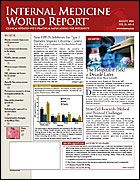Publication
Article
Internal Medicine World Report
Fat Tissue Protein Could be a new Target for Antidiabetic Therapies
Author(s):
The presence of insulin resistance is a reliable predictor of type 2 diabetes mellitus. Investigators have recently identified a protein secreted by adipose tissue that heralds insulin resistance in diverse patient populations and could lead the way to new therapies aimed at preventing the development of diabetes in high-risk persons.
Earlier research demonstrated that the expression of the primary insulin-stimulated glucose transporter, glucose-transporter 4 (GLUT4), is down-regulated in insulin-resistant states, which results in impaired insulin-stimulated glucose transport in adipocytes, and which, in turn, leads to impaired glucose tolerance (IGT).?
Previous experiments on mice that were genetically engineered to lack GLUT4 have shown that these mice have elevated serum levels of retinol-binding protein 4 (RBP4); such elevated levels have also been associated with type 2 diabetes as well as with other insulin-resistant states that stem from genetic predisposition and diet.
N Engl
J Med
In this study (. 2006;354:2552-2563), researchers sought to find the precise role of RBP4 in insulin resistance by measuring serum RBP4, insulin resistance, and the metabolic syndrome in the following 3 groups of participants:
? 5 lean men (who served as controls), 7 obese men who did not have diabetes, and 9 obese men with type 2 diabetes
? 20 individuals with normal glucose tolerance (controls), 20 individuals with IGT, and 20 with type 2 diabetes
? 26 nonobese men with ≥1 first-degree relative with type 2 diabetes.
"We found that the magnitude of increase in serum RBP4 correlates with insulin resistance among humans with obesity, impaired glucose tolerance, or type 2 diabetes and among nonobese, nondiabetic subjects with strong family histories of type 2 diabetes," write Timothy E. Graham, Beth Israel Deaconess Medical Center and Harvard Medical School, and colleagues.
In addition, elevated serum RBP4 levels were linked to a preponderance of the metabolic syndrome components, including increased body mass index, waist-to-hip ratio, serum triglycerides, and systolic blood pressure, as well as to decreased high-density lipoprotein cholesterol levels.
Although exercise training did lower RBP4 levels, this effect was only observed in those who also demonstrated improvement in insulin resistance. Finally, there was an inverse correlation between GLUT4 and serum RBP4 levels.
In an accompanying editorial (pages 2596-2598), Kenneth S. Polonsky, MD, Washington University School of Medicine, St Louis, writes that these data suggest that RBP4 "can regulate insulin-action pathways and play a role in the development of insulin resistance." But, he says, the cross-sectional study design precludes a firm determination of which is the cause and which is the effect.
He notes that many questions remain unanswered, including whether administration of synthetic retinoid therapy to reduce serum RBP4 levels would improve insulin sensitivity. Finding the answers will require "new approaches such as those used by Graham et al to identify unanticipated mechanisms underlying type 2 diabetes and to identify better treatments."






